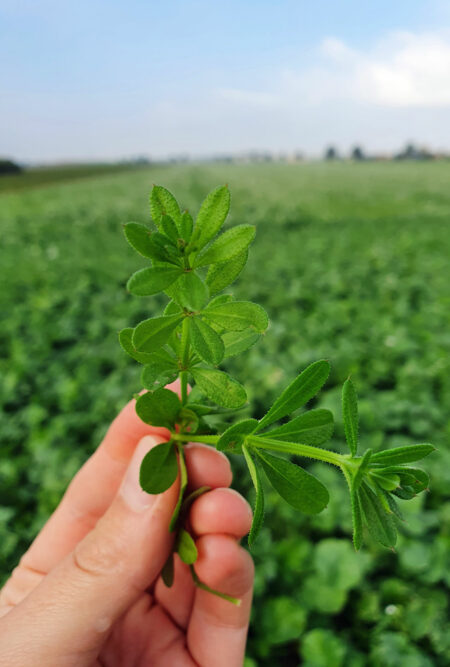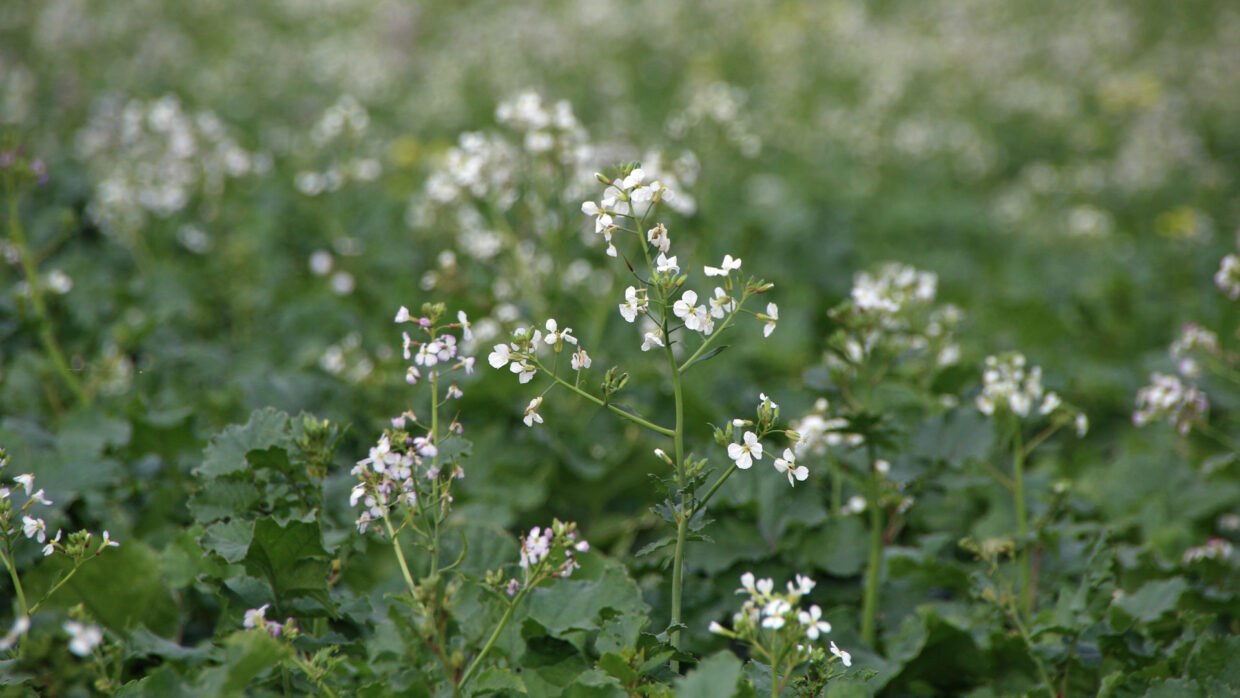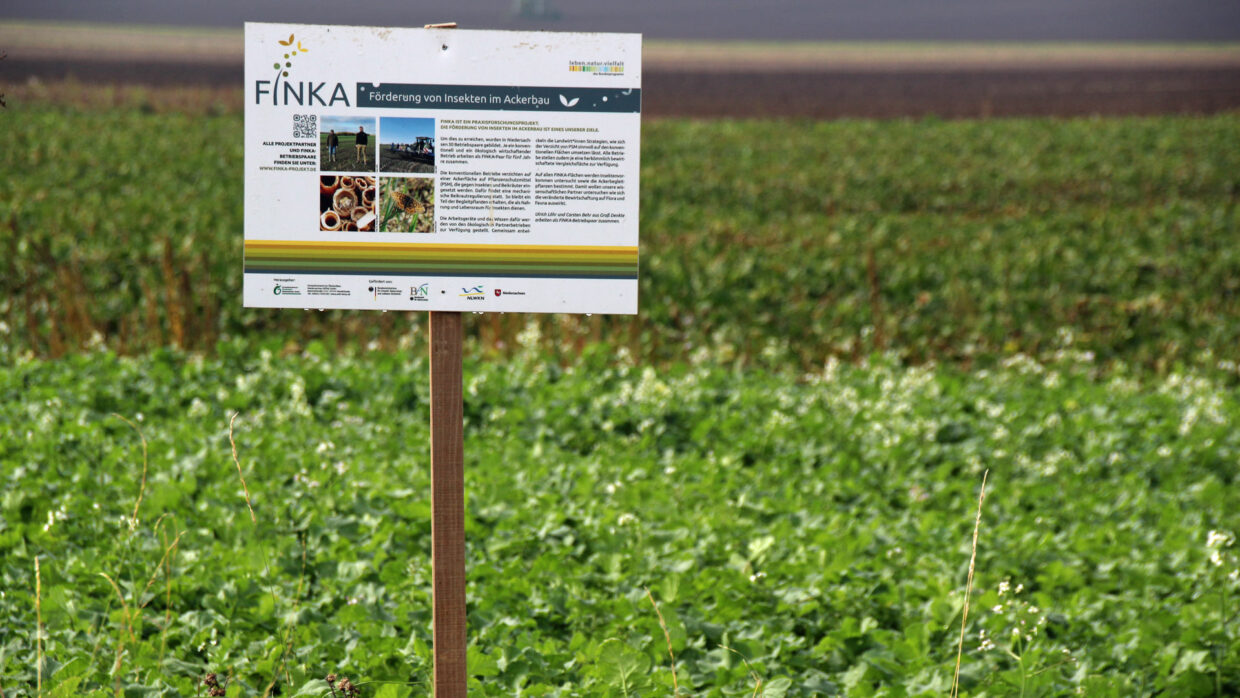Ulrich Löhr and Carsten Behr from Denkte in the district of Wolfenbüttel, Germany, are good neighbours. Their relationship is certainly not a given, since Mr Behr just completed a three-year conversion to organic agriculture, while Mr Löhr operates his farm with conventional methods. Both men have known each other for a long time and get along so well that they registered to participate in the FINKA project (a scheme to promote insects in agriculture). They will now be working closely together for five years with support from researchers.
This project in Lower Saxony intends to investigate how the diversity of beneficial weeds and insects develops on three groups of fields farmed in different ways: On fields farmed organically, on conventional fields, and on conventional fields where herbicides and insecticides are not used for the duration of the project. The project – which brings together 30 pairs of farm managers – will also research the economic effects of using fewer pesticides. Fungicides, growth regulators, and fertilisers can be used as normal. If possible, the same crops are to be grown on all three fields every year to make it easier to compare the data.
Farmers have their own interest in making sure that nature is doing well.
Dr Svenja Bänsch
The goal is to increase biodiversity in agriculture. Farming plays an important role in protecting insects since it takes up large areas of land. The results will be used to derive practical recommendations for successfully discontinuing herbicide and insecticide use. “Farmers have their own interest in making sure that nature is doing well,” explains Dr Svenja Bänsch, who provides research guidance for the project. “They work with nature. We wanted to get an idea of how to promote biodiversity in conventional agriculture.”
The neighbour saw the field more often than the farmer himself
The first FINKA season began in autumn 2020 with winter crops for all farm pairs. Messrs Behr and Löhr grew winter wheat. The conventional farmer did not use herbicides and insecticides on two hectares.
This meant he had to rely on mechanical means to control weeds, and this is where co-operation with his neighbouring farm comes into play. True to the motto “together, you are never alone”, these two farms will support, advise, and help one another with equipment. Mr Löhr was lucky with his neighbour. Mr Behr simply harrowed his trial field since he was already out there working. “I think Carsten was on my field more often than I was,” Mr Löhr recalls. “At some point, he came over and said ‘we have to harrow now’.” Mr Behr often goes over his fields to find the best time to take action.
In the first year of the project, it was easy to integrate the removal of pesticides and the resulting additional fieldwork into the overall workflow. “I didn’t have much to do with that,” Mr Löhr jokes. Thanks to his helpful neighbour, he had no additional costs at all in this year. If everything goes smoothly, it should stay that way. “There are only two hectares that directly border my fields. That keeps additional costs in check,” Mr Behr says.
Positive results after the first year
Wheat is a relatively uncomplicated crop when it comes to insects and weeds. Mr Löhr was also a little lucky since there were few insects about in the region last year. So not using insecticides did not have much of an effect. In addition, weeds were kept in check, with two passes of harrowing proving enough to compensate for not using herbicides.

Grazing flock of sheep
The first year was stress-free. Mr Löhr even suspects that the FINKA field had slightly higher yields than the conventional fields. And it cost less to grow because he was able to save on herbicides. He also did not have to sacrifice in terms of protein content or weed seed stocking. “There was hardly any difference,” Mr Löhr explains. Whether the data confirms his feelings remains to be seen until the results are in.
It helps that Mr Löhr’s field was in the right condition when the project kicked off, without any chemical resistance and very few weeds. In addition, the wheat stand was extremely thick thanks to the excellent black soil. “At the beginning, everything is always sunshine and rainbows,” Mr Behr reports from his experience. “The weed stand builds up: The third year without herbicide is a real challenge.”
Biodiversity varies greatly by farm
In the spring after the start of the project, researchers set up nesting places on the fields, followed by yellow pan traps and ground traps to count the insects.
Scientific investigations are far from being finished. Nevertheless, Dr Bänsch has already made a significant observation on the trial fields: “As soon as the accompanying flora grow in number, you see more insects on the blossoms.” Plants are a resource for the insects, and the more varied the buffet, the more likely it is that each insect will find something to eat. To what degree this observation reflects actual insect variety on the field cannot yet be said. Nocturnal species and those that live on the ground or in stems are not immediately visible when walking the field.
At first glance, the organic fields offered better living conditions for bees and wasps that nest in hollow spaces, with more nesting pipes available, says Dr Bänsch. There was no significant difference between the conventional field and the FINKA field. “The insect variety varies greatly in each case”, the researcher emphasises. “There are organic fields that were hardly any different from conventional fields in the diversity of beneficial weeds. And it seemed to me that there were conventional fields with many insects buzzing about.”
Learning from one another

Because the beneficial weeds have been mapped out, Carsten Behr learned that two types of cleavers are growing on his farm.
Mr Löhr is not concerned that the full extent of stopping herbicide use will only become apparent in a few years: “The two-hectare field is very manageable. The risk is clear to me, but this won’t kill me.” Furthermore, project participants receive a small reimbursement and are assisted by an agricultural adviser.
Mr Löhr learned about the FINKA project early because he is an active volunteer with the Landvolk Landesbauernverband [Rural Regional Farmers’ Association] and has been chairman of the Netzwerk Ackerbau [Agriculture Network] for some time. Both organisations are participating in the project. Though Mr Löhr is convinced of the benefits of conventional agriculture, he was driven by curiosity: How can one get a handle on weeds and insects without using herbicide and insecticide?
“I named the project ‘Learning from Organic Farmers’ for myself. Nobody knows what the future holds. But pesticide approvals will become more and more rare. As such, we will inevitably have to resort to more traditional measures”, he explains. He is still unwilling to switch to organic agriculture, though. “But I wouldn’t have started with FINKA if I had a fundamentally negative opinion of organic.”
The research excites his colleague Mr Behr. For him, participation in the project has already been worth it. He has learned a great deal; for example, which beneficial weeds grow on his field. “It is always said that organic agriculture is more biodiverse. I think it is important that the effects of discontinuing herbicide use are supported by solid figures. It is also very interesting that this trial is planned for several years,” Mr Behr says, describing his motive for participating in the project.
More farm operators are excited for next year. They want to grow sugar beet. Without herbicide and insecticide, that means a great deal of work to keep this root crop free of weeds. But Messrs Behr and Löhr are certain that they will be able to master this challenge together. “I would not do the FINKA project with just anyone,” Mr Löhr makes clear. “Everyone has neighbours. You have to look for friends. But, in our case, things went well.”
The farms
Ulrich Löhr
- 273ha of farmland, 7ha of grassland
- Poultry farming and biogas
- Crops: Barley, wheat, maize, rapeseed, sugar beet, peas
- Employees: 1 permanent employee, 1 trainee
Carsten Behr
- Organic cultivation according to Naturland (1st year fully recognised)
- 250ha of farmland, 9ha of grassland
- Crops: Oats, spring wheat, grain maize, sugar beet, clover-grass, broad beans
- Employees: 1 permanent employee, 2 temporary employees –> 1.5 full-time employees




